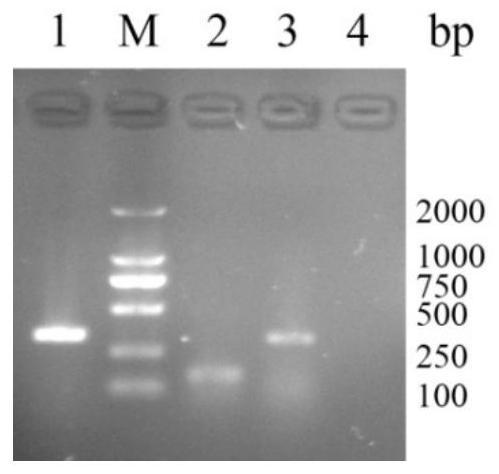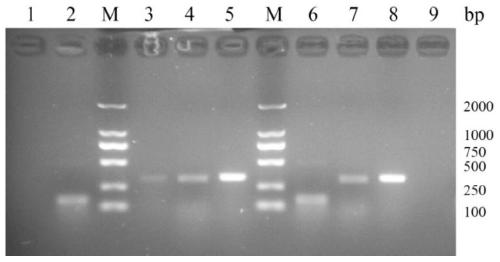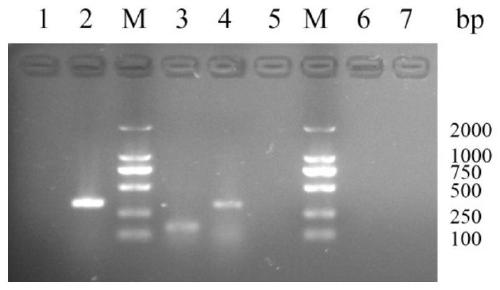One-time rapid identification method of pig, chicken and rabbit meat
A chicken and pork technology, applied in biochemical equipment and methods, microbial determination/inspection, DNA/RNA fragments, etc., can solve the problems of unstable test results, cumbersome operation, and difficulty in distinguishing mixed meat samples, and the number of primers can be reached. Reduced, reduced false positives, significant specificity
- Summary
- Abstract
- Description
- Claims
- Application Information
AI Technical Summary
Problems solved by technology
Method used
Image
Examples
Embodiment 1
[0028] Example 1: Screening of amplification primers
[0029] Firstly, the most important primers in the PCR reaction were designed, and the detection sensitivity of the designed primers was verified and screened.
[0030] 1) Primer design
[0031] The mitochondrial cytochrome b gene with obvious differences in specificity between species was selected as the target gene. At the same time, in order to realize the purpose of identifying the three species of chicken, rabbit meat and pork at one time, and reduce the number of primers added in the experiment, first Determine the highly conserved region of the cytochrome b gene of each group of species, then find out the difference region in the highly conserved region of each species, and design a specific primer set in the difference region. Use Oligo 6.0, Primer5.0, DNAMAN and other software to design multiple sets of primers, and the annealing temperature is required to be roughly the same, so that a PCR reaction can amplify 3 ...
Embodiment 2
[0043] 1. Sample preparation and DNA extraction
[0044] Take an appropriate amount of commercially available chicken and rabbit meat, mix them until homogeneous, and randomly cut out 6 portions with clean tweezers or scissors, about 20 mg each, grind them with liquid nitrogen, and place them in six 1.5mL centrifuge tubes. DNA was extracted with an animal tissue whole genome extraction kit (purchased from Beijing Quanshijin Biotechnology Co., Ltd.). Tissue digestion time is 2-3 hours. The OD of purified DNA was measured by UV spectrophotometer 260 / OD 280 All between 1.8-2.0, the concentration is 20-50ng / μL, 6 tubes of DNA are thoroughly mixed with each other to make a sample.
[0045] 2. PCR amplification
[0046] In a 25 μL PCR reaction system, 2.5 μL of 10-fold PCR buffer, 1 μmol / L of each of the four dNTPs, 2 μL of primer sets for identifying pork, chicken or rabbit meat, 1.25 U of Taq DNA polymerase, 100 ng of genomic DNA, and the rest Sterile distilled water.
[00...
Embodiment 3
[0052] 1. Sample preparation and DNA extraction
[0053] Take an appropriate amount of commercially available pork and add a small amount of chicken and rabbit meat to make dumpling fillings. Use clean tweezers or scissors to randomly cut out 6 portions, about 20 mg each, grind them with liquid nitrogen and place them in 6 1.5mL centrifuge tubes. DNA was extracted with an animal tissue whole genome extraction kit (purchased from Beijing Quanshijin Biotechnology Co., Ltd.). Tissue digestion time is 2-3 hours. The OD of purified DNA was measured by UV spectrophotometer 260 / OD 280 All between 1.8-2.0, the concentration is 20-50ng / μL, 6 tubes of DNA are thoroughly mixed with each other to make a sample.
[0054] 2. PCR amplification
[0055] In a 25 μL PCR reaction system, 2.5 μL of 10-fold PCR buffer, 1 μmol / L of each of the four dNTPs, 2 μL of primer sets for identifying pork, chicken or rabbit meat, 1.25 U of Taq DNA polymerase, 100 ng of genomic DNA, and the rest Sterile...
PUM
 Login to View More
Login to View More Abstract
Description
Claims
Application Information
 Login to View More
Login to View More - R&D
- Intellectual Property
- Life Sciences
- Materials
- Tech Scout
- Unparalleled Data Quality
- Higher Quality Content
- 60% Fewer Hallucinations
Browse by: Latest US Patents, China's latest patents, Technical Efficacy Thesaurus, Application Domain, Technology Topic, Popular Technical Reports.
© 2025 PatSnap. All rights reserved.Legal|Privacy policy|Modern Slavery Act Transparency Statement|Sitemap|About US| Contact US: help@patsnap.com



